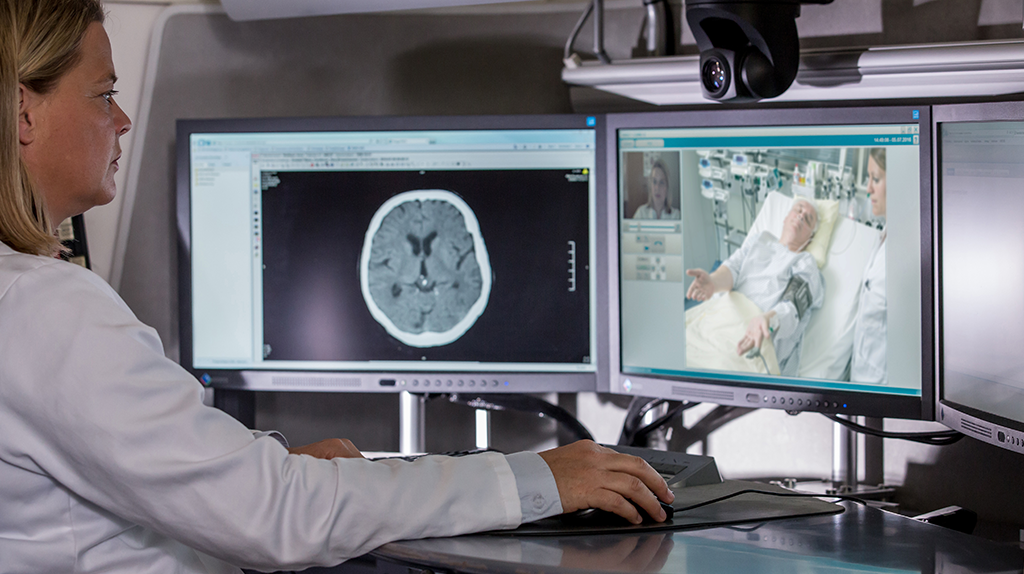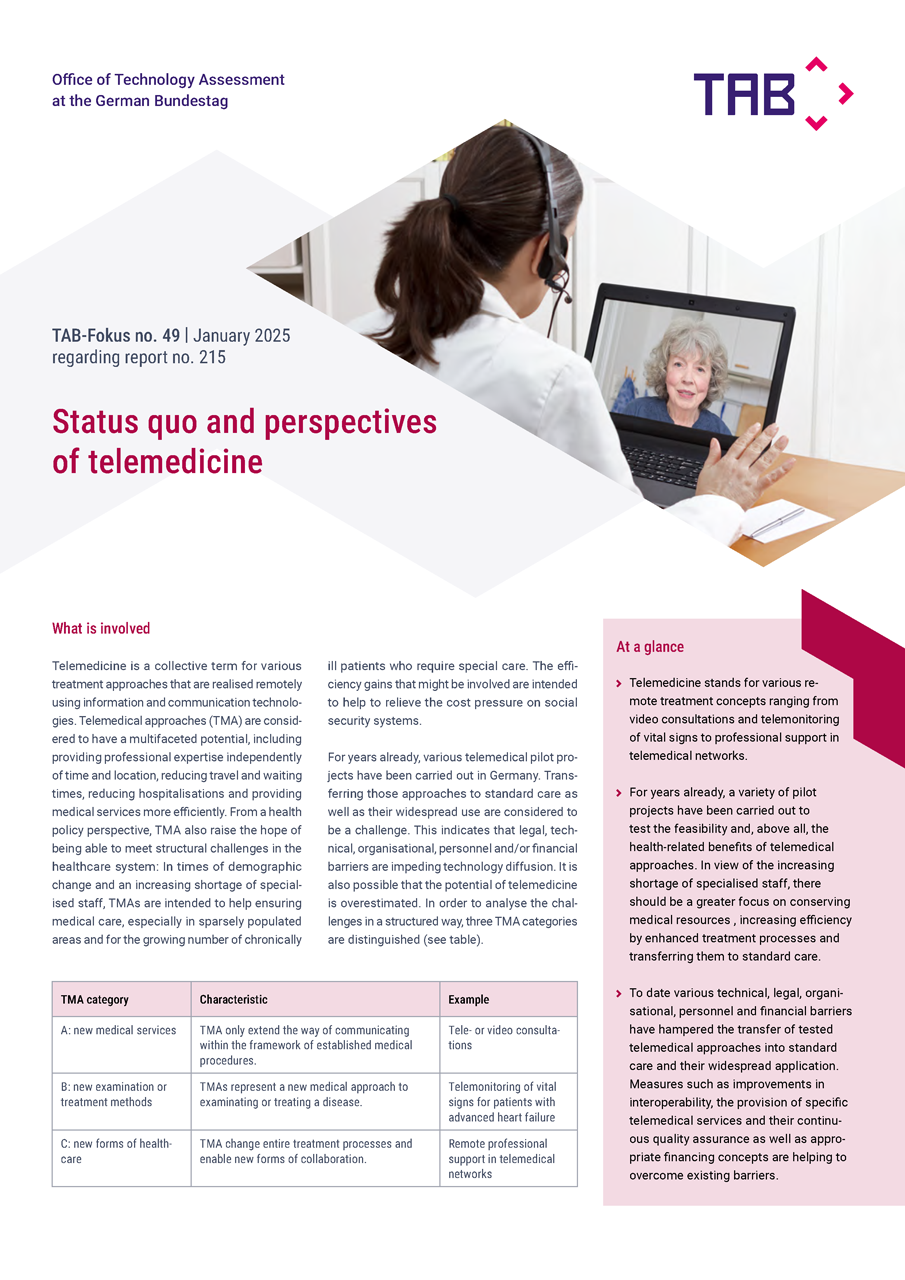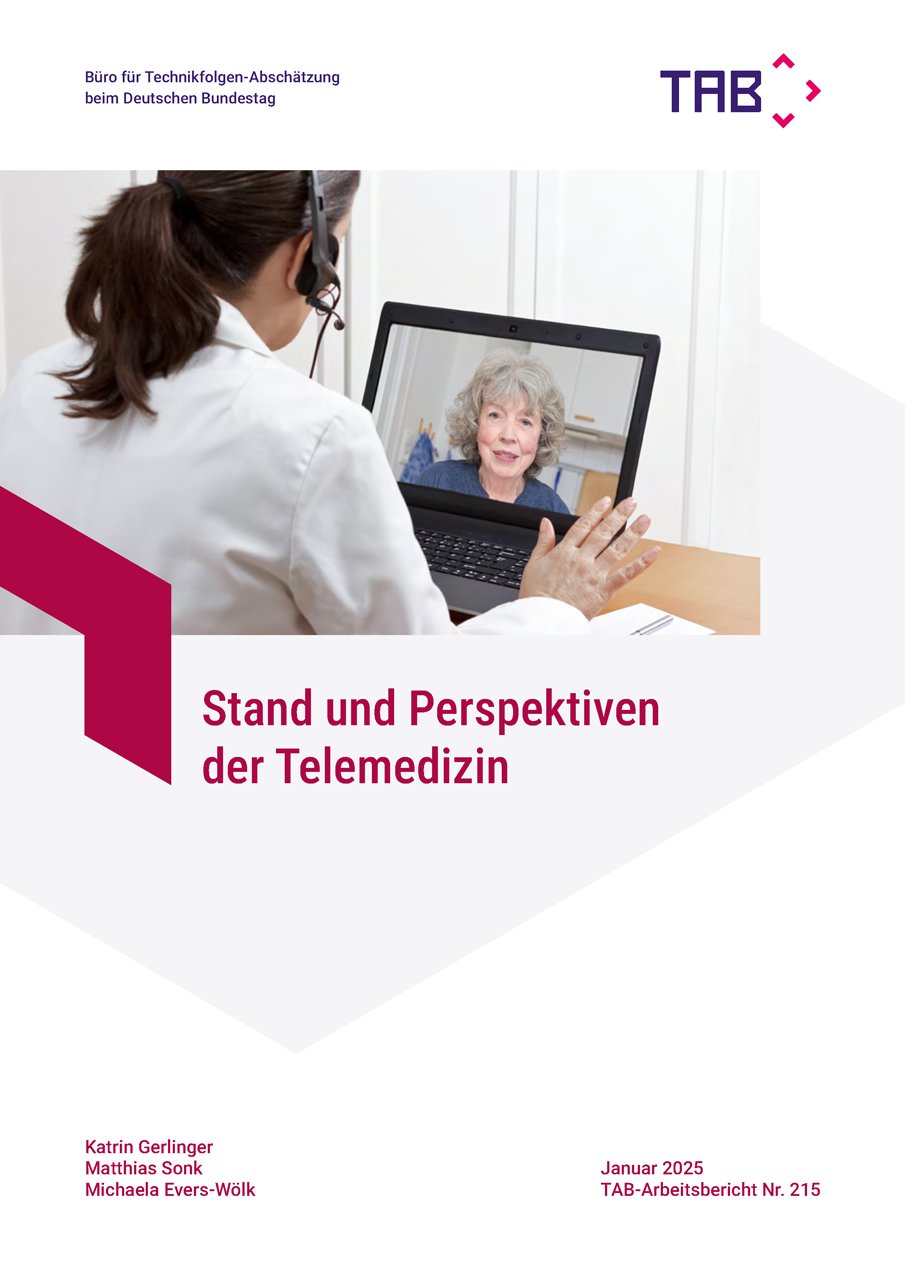
Status quo and perspectives of telemedicine
- Project team:
Katrin Gerlinger (Project Manager); Michaela Evers-Wölk
- Thematic area:
- Topic initiative:
Committee on Education, Research and Technology Assessment
- Analytical approach:
TA project
- Startdate:
2019
- Enddate:
2025
The final report on the TA project was approved by the Committee on Education, Research and Technology Assessment on 29 January 2025.
Status quo and perspectives of telemedicine
At a glance
- Telemedicine stands for various remote treatment concepts ranging from video consultations and telemonitoring of vital signs to professional support in telemedical networks.
- For years already, a variety of pilot projects have been carried out to test the feasibility and, above all, the health-related benefits of telemedical approaches. In view of the increasing shortage of specialised staff, there should be a greater focus on conserving medical resources , increasing efficiency by enhanced treatment processes and transferring them to standard care.
- To date various technical, legal, organisational, personnel and financial barriers have hampered the transfer of tested telemedical approaches into standard care and their widespread application. Measures such as improvements in interoperability, the provision of specific telemedical services and their continuous quality assurance as well as appropriate financing concepts are helping to overcome existing barriers.
sprungmarken_marker_4814
What is involved
Telemedicine is a collective term for various treatment approaches that are realised remotely using information and communication technologies. Telemedical approaches (TMA) are considered to have a multifaceted potential, including providing professional expertise independently of time and location, reducing travel and waiting times, reducing hospitalisations and providing medical services more efficiently. From a health policy perspective, TMA also raise the hope of being able to meet structural challenges in the healthcare system: In times of demographic change and an increasing shortage of specialised staff, TMA are intended to help ensuring medical care, especially in sparsely populated areas and for the growing number of chronically ill patients who require special care. The efficiency gains that might be involved are intended to help to relieve the cost pressure on social security systems.
For years already, various telemedical pilot projects have been carried out in Germany. Transferring those approaches to standard care as well as their widespread use are considered to be a challenge. This indicates that legal, technical, organisational, personnel and/or financial barriers are impeding technology diffusion. It is also possible that the potential of telemedicine is overestimated. In order to analyse the challenges in a structured way, three TMA categories are distinguished (see table).
| TMA category | Characteristic | Example |
|---|---|---|
| A: new medical services | TMA only extend the way of communicating within the framework of established medical procedures. | Tele- or video consultations |
| B: new examination or treatment methods | TMA represent a new medical approach to examinating or treating a disease. | Telemonitoring of vital signs for patients with advanced heart failure |
| C: new forms of healthcare | TMA change entire treatment processes and enable new forms of collaboration. | Remote professional support in telemedical networks |
Legal structure of telemedical service provision
Doctors play a key role in (tele)medical treatment. In legal terms, they owe their patients a careful medical treatment in accordance with recognised professional standards. Telemedical approaches must be anchored in education and training as well as in numerous clinical guidelines in order to lay the necessary professional foundations for their application and for ensuring a careful approach.
Patients are obliged to pay for (tele)medical services, which are usually covered by the statutory health insurance (SHI, German abbr. GKV). Which (tele)medical services are reimbursed by the SHI, how they are to be provided and how they are remunerated is defined in principle in the German Social Code Book V and specified in various guidelines, agreements, lists and catalogues. These are drawn up by various bodies of self-government and become legally effective through collectively agreed medical care contracts. They define the standard care provided by the SHI system, which is organised, implemented and remunerated independently in the outpatient and inpatient sectors. In order to promote (tele)medical innovations, individual health insurance companies can also conclude selective medical care contracts with a wide range of service providers and, among other things, agree upon telemedical services that go beyond standard care or upon the implementation of corresponding pilot projects. Such additional offers are not available to all insured persons.
The inclusion of different TMA in the administrative structures of the outpatient and/or inpatient sector is a necessary precondition, but does not guarantee their application. The doctors and medical professionals involved must be able to integrate the TMA into their work processes, thereby adding medical benefit and being remunerated appropriately.
Technical aspects
As a minimum, those involved in the respective telemedical process (doctors, medical professionals, patients) require a terminal device, a reliable Internet connection , specific communication services and corresponding application skills. TMA have a particular potential where the people involved not only communicate audiovisually or verbally, but also collect, share and analyse treatment-relevant data in order to be able to assess medical issues more specifically from a distance. Devices and software used to collect and analyse data for the diagnosis and treatment of diseases are medical devices subject to certification. Some are only used in medical institutions (e. g. CT and MRI equipment). The data collected are analysed and stored using special information systems. These systems are usually institution-specific, proprietary stand-alone software solutions with heterogeneous data structures that are subject to the highest standards of protection. Increasingly, there are also devices and apps that patients can use to collect vital data relevant to their treatment themselves and transmit them to special platforms that give selectively access to doctors.
For years, both at the national and international level, work has been done regarding standardised medical specifications, standards, interfaces and profiles for data management. With the establishment and expansion of the telematics infrastructure (TI) and the first telemedically relevant services (e. g. electronic prescriptions, certificates of incapacity for work as well as patients’ health records), the technical foundation for TMA is improving. Nevertheless, considerable efforts to digitise healthcare processes and improve interoperability will still be necessary in the future in order to be able to use TMA efficiently and achieve benefit.
Video consultations/teleconsultations in Switzerland and Germany
At the turn of the millennium already, a teleclinic with a treatment concept based exclusively on teleconsultations was approved in Switzerland. This concept includes the following:
- a structured initial assessment of those seeking advice,
- a special training programme with certification for doctors working at the teleclinic,
- guidelines for telemedical conversational techniques and intensive support of patients,
- a specific information and quality management system for documentation, tracking the course of a disease and monitoring defined quality indicators, and
- a nationwide network of cooperating medical institutions that provide any necessary examinations and treatments on site.
The Swiss teleclinic is now the largest in Europe, with 140 teledoctors providing 24/7 telemedical services to patients throughout the country via telephone, video and chat. Approximately 50 % of the callers can be provided full telemedical care. The others are preferably treated in cooperation with the network institutions or referred to the emergency services.
In Germany, doctors working on an outpatient basis have been allowed to carry out teleconsultations to a limited extent in addition to face-to-face treatment and to bill them to the statutory health insurance scheme since 2017. For this, no training is required. To date, only a few medical guidelines include information on the use of teleconsultations. Although many doctors have gained experience of using teleconsultations during the COVID-19 pandemic, only psychotherapists are currently using them to a greater extent (approx. 50 %). This proportion is much lower for other specialist groups (8 % of general practitioners, other specialists even less). So far, pure teleclinics have not been authorised to provide standard care in accordance with the SHI system. Since only a few doctors offer teleconsultations, online portals are relevant for matching telemedical services offered and patients’ demand. Now that the first commercial providers have expanded their portals accordingly, associations of SHI-accredited doctors are now following, primarily to relieve the burden on on-call doctors.
Advocates of teleclinic concepts emphasise the more flexible working models, reduced travel and waiting times as well as a relief for acute care and emergency services. In Germany, SHI-accredited doctors and their associations are rather critical of the concept. They show no willingness to cooperate with teleclinics in the future in order to continue treatments on site if necessary. As a result, treatment safety would not be guaranteed in many cases. Moreover, from the point of view of the SHI-accredited doctors, teleclinics would jeopardise established demand planning and service remuneration (currently, among other things, treatment cases requiring a high level of care are partly cross-financed via minor cases).
Telemonitoring
With telemonitoring, patients regularly transmit defined vital data to special platforms where these data are collected and medically monitored in order to detect any irregularities early from a distance and take countermeasures immediately. First concepts were developed around the turn of the millennium for patients suffering from heart failure who wore special data-transmitting pacemakers (type 1 monitoring). In 2015, this concept was categorised as a new treatment method within the SHI framework and a complex evaluation procedure was initiated by the German Federal Joint Committee (German abbr. G-BA). Moreover, telemonitoring concepts have been developed to monitor classical vital signs (including weight, blood pressure, well-being) that need to be checked regularly anyway in the case of heart failure (type 2 monitoring). Studies have been conducted in a number of countries in which patients were given measuring devices and special apps with various functionalities (i. a. for data management, personal monitoring and communication with study centres as well as including information material on the course of the disease). Heterogeneous study settings and results made the evaluation difficult. It was not until the end of 2020 that a slight benefit of both concepts was recognised in a small group of patients, the procedure was specified and quality assurance measures and remuneration were defined. Since April 2022, patients in this small group can be regularly monitored remotely and the corresponding services can be billed. For this, telemonitoring centres (German abbr. TMZ) led by cardiologists must be set up and certified. They are responsible for the procedure, but can delegate some services (i. a. patients’ equipment and care, platform operation).
There are a number of points of criticism regarding the present approach, for example: Type 2 monitoring concepts are not a new treatment method and the complex evaluation procedure is inappropriate. A faster approval procedure is required in order to be able to quickly extend telemonitoring to other treatment contexts. The fast-track procedure for digital health applications would be an option, as special apps are used anyway. The TMZ-based approach is resource-intensive, requires considerable coordination between TMZs, patients and primary care physicians and is associated with certain uncertainties regarding liability. Although TMZs require a licence, the service providers with their apps and platforms do not. It is unclear whether all activities are adequately remunerated.
Telemedical networks
The first regional teleradiology networks emerged in Germany at the turn of the millennium with a teleradiological centre to which cooperating clinics can transmit radiological images via a secure communication network and receive rapid image results. In other telemedicine networks, medical experts in specialised centres provide targeted guidance to treatment teams in cooperating institutions (e. g. in stroke or intensive care networks, in telemedicine emergency concepts). The centres set up teleworking stations and ensure teleconsultation services by medical specialists. Cooperating institutions must be specifically equipped as well in order to call in experts for treatment, carry out diagnostics and special treatments on site and transmit data and information. Regular training, certifications, guidelines on procedures and quality assurance measures (i. a. case registrations) are integral parts of the concepts. Such networks can change established forms of medical care more comprehensively. To achieve this, the digitisation of medical processes must be enhanced and the resulting treatment data must be standardised to a greater extent and usable across institutions. In addition to the technical challenges involved, various organisational, administrative, financial and legal aspects (e. g. regarding liability) need to be clarified.
It seems plausible that such networks can help to provide special medical expertise even in structurally weak regions. However, cooperating institutions must be capable – technically and in terms of human resources – of implementing the respective recommendations and carrying out the treatments. Currently, the doctors, paramedics and nursing staff required for this are already in short supply and in some cases overworked. It is unlikely that they will be relieved by teleconsultation enquiries and experts connected via telemedical services.
Bedside televisiting

Workplace in a telemedicine center

Options for action
There are options for action both across the board for all TMA and specifically:
Technical aspects: On the one hand, the expansion of broadband and mobile networks in medically underserved regions should be prioritised and the connection of medical institutions driven forward. On the other hand, the digitisation of medical care processes, the development and use of uniform standards and nomenclatures, the improvement of interoperability of technical components and the secure networking of IT systems remain highly relevant ongoing tasks.
Enhancement of expertise: TMA should be addressed more comprehensively in education and training as well as in treatment guidelines. Education and training concepts should be developed for new job profiles (e. g. digital medical technicians). Special digital technology service centres could provide support in terms of application. Target group-specific information and support concepts should be developed for patients.
In telemedical pilot projects, greater attention should be paid to the use of resources and efficiency gains. For this purpose, examination methods should be further developed and evaluation processes should be streamlined and accelerated.
Applied research into the use of teleconsultations should be funded in order to ensure effective, resource-efficient application in view of an increasing shortage of specialised staff. A 24/7 teleconsultation service should be set up and expanded to relieve the burden on acute and emergency care on site. For this, the success factors of the Swiss teleclinic concept should be taken into account (structured initial assessment, guidelines for conversational skills, an appropriate information and documentation system with a quality monitoring concept and training of specialists and doctors regarding its use).
For telemonitoring concepts, method assessments by the German Federal Joint Committee (G-BA) should be limited to necessary cases, the required technical elements and services should be certified and accompanying research should be strengthened in order to further develop the first regularly operational concepts in a practice-oriented way. Different elements ranging from integrated care by specialised networks to complex TMZ-based telemonitoring and to self-management of vital signs monitoring as well as the necessary approval and certification procedures for the respective components should be gradually brought together to form an overall telemonitoring concept that can also be transferred to other application contexts.
Telemedical networks are likely to have the strongest impact on existing care structures in the future. They are an element of the hospital reform adopted in autumn 2024 and the planned emergency reform, which will also require a wide range of health policy decisions in the future. For this, among others, technical and personnel requirements as well as legal responsibilities must be defined, participating institutions must be qualified, certification procedures must be developed and implemented. Data sharing should be promoted and long-term funding for network activities secured. Some networks have already been gathering application experience for years. This experience can provide valuable information on the opportunities and challenges of expanding cross-sectoral medical care structures. A parliamentary expert discussion with network operators and other relevant stakeholders might provide a suitable forum for jointly identifying viable solutions.
Downloads
|
TAB-Fokus no. 49 Status quo perspectives and of telemedicine (PDF) The policy brief TAB-Fokus no. 49 summarises the most important findings of the TA project on four pages. |
|
|
|
TAB-Arbeitsbericht Nr. 215 Stand und Perspektiven der Telemedizin (PDF) The TAB report provides a comprehensive overview of the technical, medical, administrative and legal aspects of telemedicine approaches and their current status. It identifies existing challenges and highlights areas requiring further research and action. This gives political decision-makers sound guidance for future policy decisions. |
||
|
TAB-Sensor Nr. 4 (2022) Wie bewerten Bürger/innen die Telemedizin? Ergebnisse einer Repräsentativbefragung (How do citizens rate telemedicine? Results of a representative survey) The TAB sensor complemented the TA project. It focuses on patients' and citizens' views on telemedicine services. It also considers the impact of telemedicine on the doctor-patient relationship, as well as the pros and cons of video consultations. |


